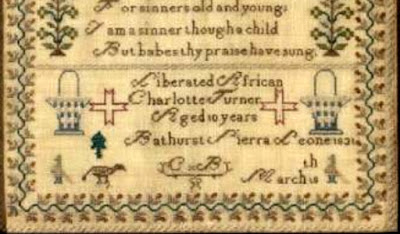Here's an arresting image on a sampler.
"Pity the Negro Slave
Emancipated In 1832
Hannah Shields"
I do not know the source. Found it on the internet. But I have learned more about it.
York Castle Museum, England
Here's another. Same pattern, also 1832. The only difference is the name:
Sarah Sedgewick.
And a third from 1832 with no name---from a New
Jersey auction several months ago.
Next Thursday evening February 4th I am going to give a virtual lecture
Threads of Dissent: Antislavery Needlework at Gunston Hall in Virginia.
7:00 Eastern
Here's a link.
These are embroidered samplers, probably school girls' work.
The colored threads are wool or silk, cross-stitched onto a coarse
background, perhaps linen or wool, leaving much of the background showing
The image is of a black person in chains...
Several antislavery societies used this effective visual as their logo beginning in 1787.
Detail of a quilt by Deborah Simmons Coates,
Chester County Pennsylvania
Lancaster Historical Society
And many needleworkers used the image in their textiles to show solidarity with the cause,
to raise funds and to raise awareness of the inhumanity of slavery.
International Quilt Museum
Detail of a quilt made for Sarah Wistar, 1842-1843
Philadelphia
D.A.R. Museum
Pinholder or pin wheel
Pins are stuck around the circle's perimeter.
Small needlework items were sold at antislavery fairs to raise
money for the cause.
But these "Emancipated" samplers have a different story
Recaptured children and adults
Michael Graham Stewart Collection
National Maritime Museum, Greenwich, England
The Graham Stewart Collection is a large collection of images of slavery.
Outlawing the trade did not end it. Africans continued to capture their neighbors; traders at African ports continued to sell them to shippers; shippers took them to the Americas.
University of Virginia Libraries
But an occasional ship was intercepted by patrols and the human cargo released---recaptured into freedom and settled in Freetown in Sierra Leone.

Museum of London
Children were Christianized in missionary children's homes.
One could view the settlements as refugee camps.
To support the missionary work managers appealed to donors world wide. One fundraising effort involved these samplers. A woman, say Miss Hannah Shields in Boston, might send a donation and for her gift the teachers would name a girl after her. (Suggested donation: 5 pounds a year for six years.)
The child who once had an African name would become another Hannah Shields and stitch a sampler for her benefactor with their common name. The sampler went to the United States --- or Germany or England. This system of fostering missionary school children and renaming them also went on in India, Ceylon and in schools for Native American children in the United States with a few linked surviving samplers.
Museum of London
School in Sierra Leone
When Silke Strickrodt wrote her article on the samplers ten years ago she had found 13 African samplers but none looked like those with the British society logo of the kneeling man.
The Church Mission Society in Africa has several in their collection.
Amy Finkel at M. Finkel and Daughter, who specializes in antique samplers, has posted two on the internet.
Charlotte Turner, aged 10 years, 1831
Silk on wool
Charlotte's sampler is now in the Seattle Art Museum
Gloucester, a town in Sierra Leone, was the location of one of the missionary schools,.
Srickrodt tells us these textile documents present "serious problems in interpretation."
And identification.
British or African?
Hannah Bloor 1840
Philadelphia Museum of Art
https://www.jstor.org/stable/40864625?seq=1#metadata_info_tab_contents
See also a Native American missionary school sampler sold at a Sotheby's Auction with much information in the catalog notes here:



























2 comments:
I have re-enabled the comments. Let's see how weird they get.
OK, I'll try. This is another history lesson that needs to be told. Thank you.
Post a Comment